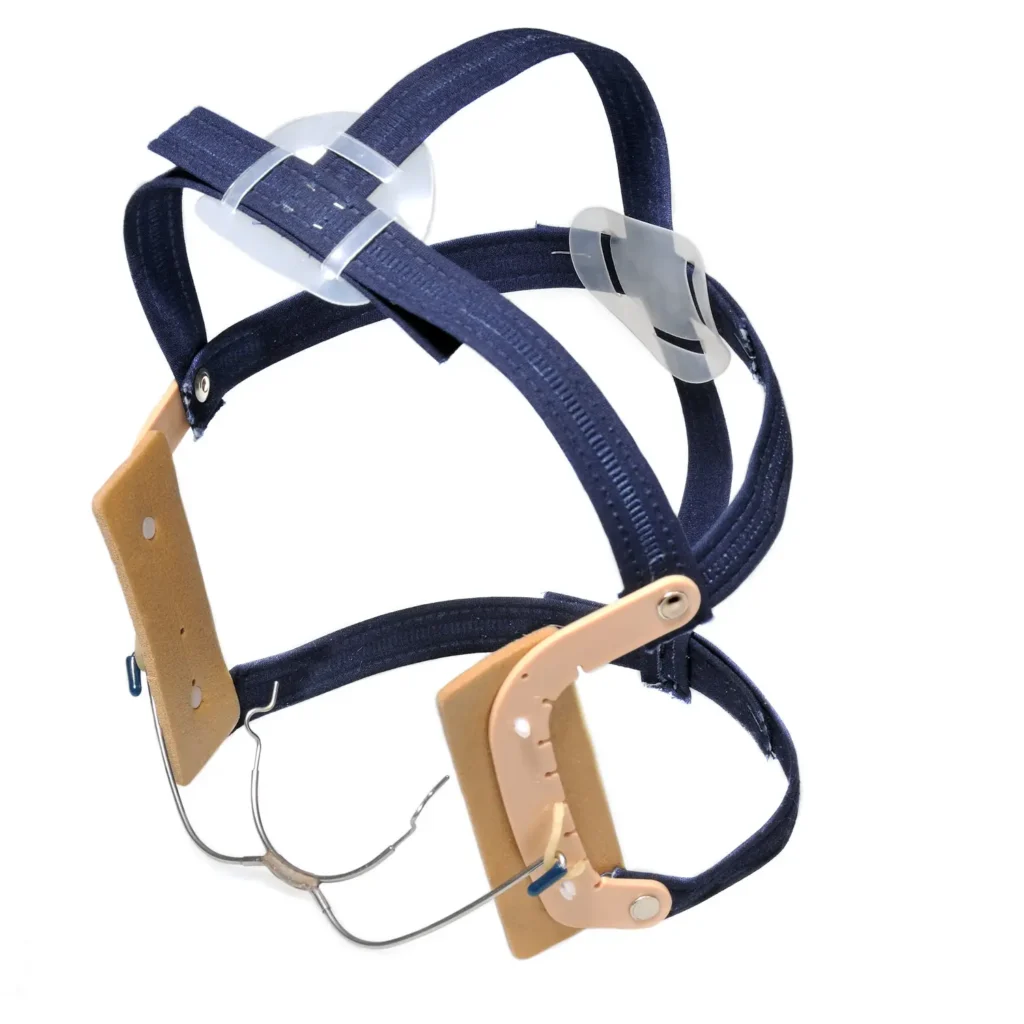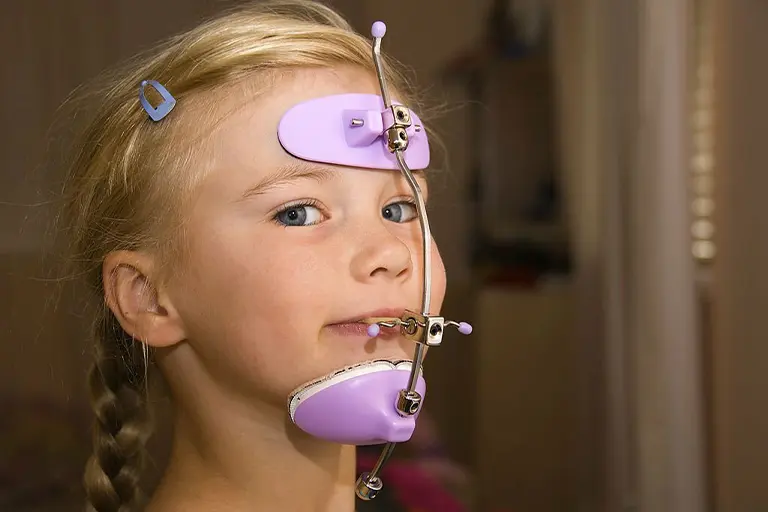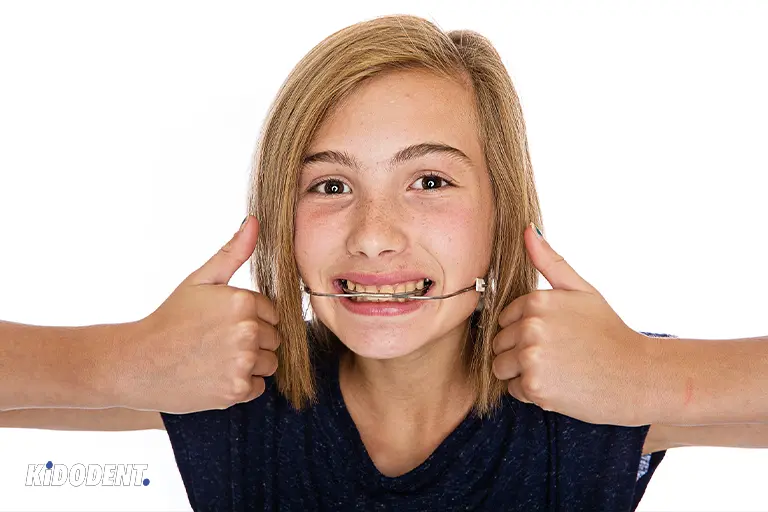What is headgear?
Headgear is an orthodontic appliance to treat jaw and facial deformities. Unlike most orthodontic appliances that you wear in the mouth, headgear is an extraoral appliance, which means you wear it out of your mouth and orthodontists use other parts outside the mouth to anchor (to fit in place) the appliance.
In orthodontics, changing the growth of the bone in the jaws is one of the main treatments to get to the aligned and right shape for your appearance. Headgear is the best treatment to correct jaw abnormalities especially when your child is still in growing age. Some people may choose surgeries for their jaw correction because their facial growth is no longer in development. But if treatment starts at earlier phases of children’s development, surgeries in adulthood will not be necessary.
What does headgear do (the purpose of headgear in orthodontics)?
The purpose of headgear is to manage and control the skeletal growth of jaws into the normal growth pattern so the irregularities in teeth and jaws will disappear.
Overbite is one of the most common malocclusions that headgear is used as a treatment device. It occurs when the upper teeth fall over or overlap the lower teeth, and the amount of protrusion of the upper front teeth over the lower front teeth is overjet. Orthodontists call overbite with its medical name, class Ⅱ of malocclusion. So, what orthodontic headgears do is to align and correct these jaw discrepancies and improve this malocclusion into the fitted and normal position.
Headgear is also one of the orthodontic tools to be used along with other orthodontic appliances in the treatment of underbite, in which the lower jaw has grown excessively and has protruded into a forward position. This is also known as class Ⅲ malocclusion. So when upper teeth fall inside the lower front teeth, the results are underbite. Sometimes, other bite problems like crossbite can exist. Headgear therapy, therefore, is one option for treating these teeth and jaw problems.

What are the main parts of a headgear?
Each orthodontic headgear has three main components:
- Facebow: Facebow consists of a set of stainless steel wires that have inner and outer bows that connects the caps, the straps, and the inner (in the mouth) orthodontic appliances
- Pads for anchorage: Headgear uses anchorage outside of the mouth to intrude or extrude jaws or teeth. In different types of headgear, anchorage pads can be on the occipital area (back of the head) or cervical area (around the neck)
- Strap: straps are used for pulling or traction. Depending on the type of headgear, straps wrap around the head or neck to adjust the desired fitting in the treatment process.
What are the types of headgear?
Headgear has different designs and types depending on the kind of treatment. Orthodontists use these designs of headgear to get the necessary treatment in patients. The main types of headgear are:
- Cervical pull headgear: Cervical designs of headgear wraps around the neck and use the cervical area for its anchorage pad. Cervical headgear is best indicated to treat overbite and if jaw growth is horizontally growing. Generally, cervical pull headgear is used when the proportion of the vertical dimension of the face is normal.
- High-pull headgear: In high-pull headgear, the anchorage pad is located on the back of the head or occipital area. Orthodontists use high-pull headgear when vertical force is needed to intrude the upper jaw and teeth. If the lower part of the face has abnormal excess and has increased facial height, high-pull headgear is normally used as the treatment option.
- Combination of high-pull and cervical headgear: The combination headgear is used when the type of force needs both cervical anchorage and high-pull anchorage to control or push jaws into the fitted position.
- Reverse-pull headgear (known as facemask): Reverse-pull headgear is used to treat upper jaw deficiencies or underbite in children. This type of headgear, as the name suggests, is a face mask that is fixed over your face. Facemask has plastic or fabric-made pads or caps that fit on the forehead and chin.
Uses of headgear
- Headgear treats protrusion of the jaws
- The most effective appliance to treat the upper jaw protrusion
- To correct overbite (when upper jaw teeth are in forward and fall over on the front teeth in the lower jaw)
- Headgear in conjunction with other orthodontic appliances can treat open bite
- To correct jaw and teeth abnormalities in growth ages
- Expanding or management of back teeth (molars)
- Correction of crowded teeth (when children get to the mixed dentition periods, crowded teeth become a problem)
- Bone modeling of the jaws and teeth
- As an anchorage in orthodontics
Advantages of headgear
- Headgear is a safe way to guide jaw growth into normal shape.
- Headgear is one of the best ways to prevent extreme jaw irregularities in adulthood.
- Headgear makes orthodontic treatment of your child easier later.
- Saves time in future orthodontic treatment if done earlier in children.
- Prevents root resorption of teeth when high pressure to move teeth is necessary.
- As an extraoral orthodontic appliance, orthodontists can easily adjust forces to achieve better occlusion for jaws and teeth.
What is the common disadvantage of headgear?
If we name the important disadvantage of headgear in orthodontics, we should just point to the one thing that makes headgear a little hard to accept. It is the design and shape of the headgears, which are visible with the bow-like wires in or around the face or other straps and tools of this appliance. Because of that, most people may not accept wearing that.
Children, too, may have a fear to wear headgear while they are at school or near their friends. Since they may feel embarrassed, it is hard to convince them to wear headgear.
Among the headgears, reverse-pull headgear may have this weird design and shape, which causes children to deny wearing that. Some types of headgear like the Delaire-type facemask or the reverse-pull headgear type may create problems for children such as difficulty in sleeping or even wearing glasses, but you can overcome these problems by using a rail-type facemask.

How can you persuade children to wear headgear?
If you think about the benefits of headgear and the safety of this orthodontic appliance, you are more likely to select that as your treatment option.
To convince your child, you can talk them into doing that, or you can explain to your child that it is just a matter of some months. They can get used to the headgear in their daily life and the difficulties that may come up during the treatment will disappear slowly.
Just think of the positive transformation of the jaws and irregularities of teeth that will go away. You can see that the good results of your child’s headgear therapy were worth the social obstacles that they faced.
